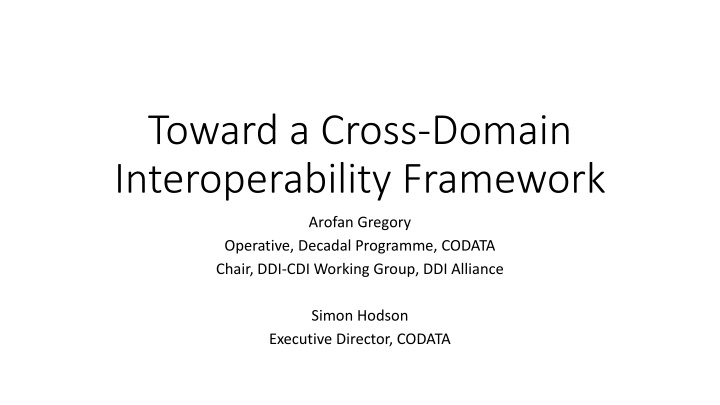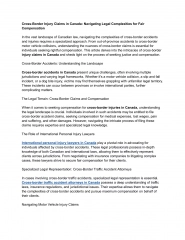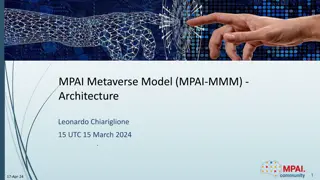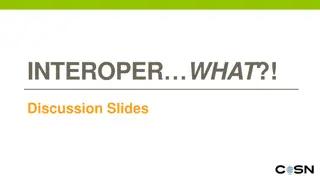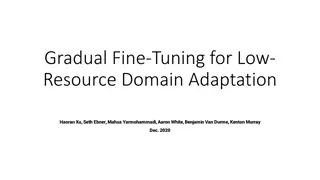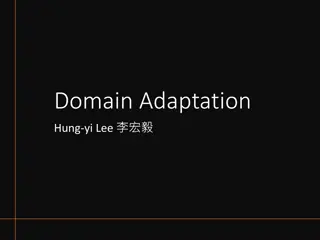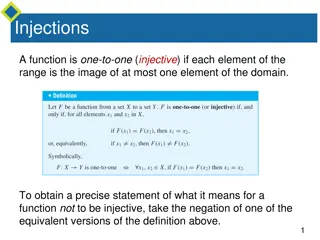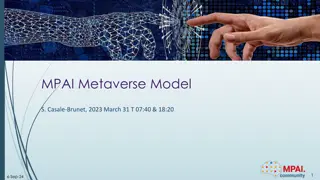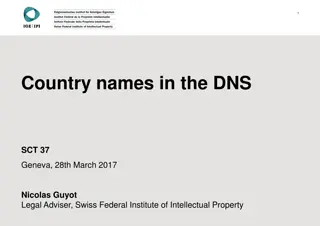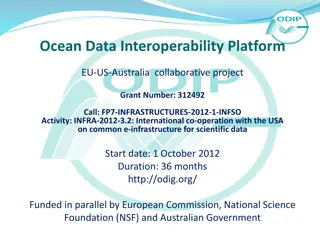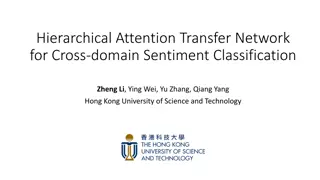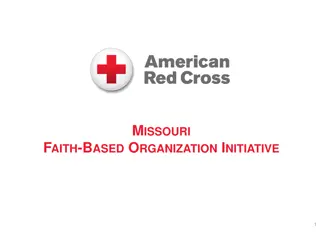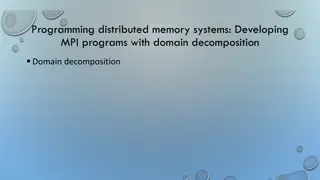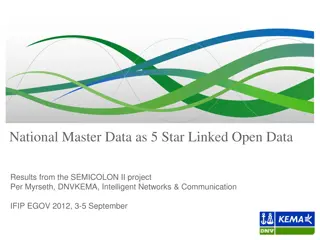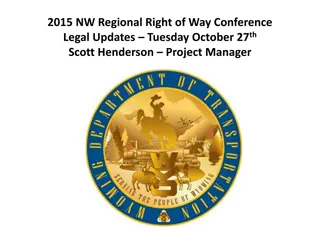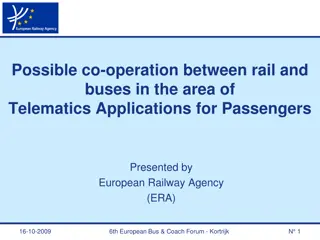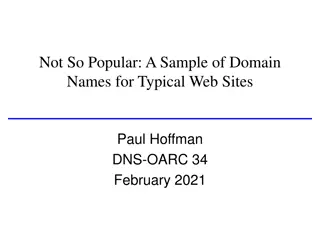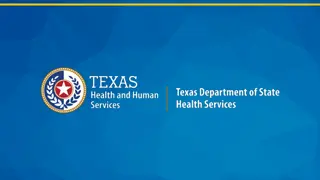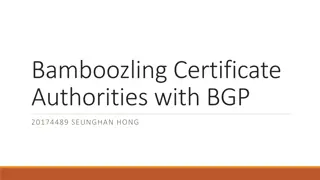Toward a Cross-Domain Interoperability Framework
Outline the challenges and requirements for achieving cross-domain interoperability in data sharing, including the FAIR Digital Object Framework and key components like FAIR Implementation Profile and Data Point. Addressing the need for standards across diverse domains and communities to make the vision of seamless data integration a reality
Download Presentation

Please find below an Image/Link to download the presentation.
The content on the website is provided AS IS for your information and personal use only. It may not be sold, licensed, or shared on other websites without obtaining consent from the author.If you encounter any issues during the download, it is possible that the publisher has removed the file from their server.
You are allowed to download the files provided on this website for personal or commercial use, subject to the condition that they are used lawfully. All files are the property of their respective owners.
The content on the website is provided AS IS for your information and personal use only. It may not be sold, licensed, or shared on other websites without obtaining consent from the author.
E N D
Presentation Transcript
Toward a Cross-Domain Interoperability Framework Arofan Gregory Operative, Decadal Programme, CODATA Chair, DDI-CDI Working Group, DDI Alliance Simon Hodson Executive Director, CODATA
Outline The FAIR Challenge across Domains Market Dynamics and Practical Implementation What Makes a Standard Cross-Domain ? The Cross-Domain Interoperability Framework: Some Pieces of the Puzzle Conclusions and Next Steps
The FAIR Challenge across Domains
The Cross-Domain FAIR Vision Users (both human and machine) can locate data of interest within or outside of their own domains/communities They can determine and comply with the conditions of use They can access and understand the data They can integrate it with other data
Really? To make this vision a reality, there are some hard requirements: Exchange of large amounts of detailed information (data and metadata) Interactions at many different technical levels Ability to make the information exchanges at each level machine-actionable (to support increase in scale) This demands that each level of interaction be supported by standards for information exchange across domains This demands agreement on what the different levels of interaction are, and which standards will be used This must be done, while recognizing that different domains have very different standards, data lifecycles, and workflows And different semantics! The challenges of adoption are massive!
The FAIR Digital Object Framework (FDOF) The FDOF is now under development, but looks to become the basic set of protocols used for FAIR implementation It has a number of components: FAIR Implementation Profile (FIP): A description of how a given domain/community will support FAIR sharing, including significant FDPs FAIR Data Point (FDP): A repository or distribution point for FAIR digital objects, supporting the FDOF protocols FAIR Digital Object (FDO): A digital object described in RDF using the FDOF protocols, including pointers to relevant metadata and metadata schemas
Registry of Catalogues FAIR Data Point PID ACCESS (By Domain) FIPs (By Domain) DATA FAIR Digital (Data) Object The FDOF provides the types of objects STRUCTURAL METADATA PROVENANCE/ PROCESS METADATA (META)METADATA RESOURCES SEMANTICS/ CLASSIFICATIONS
Whats Wrong with This Picture? Question: Once you get the FDO you are after, how many standards will you need to understand to be able to actually use it? Answer: Too many. You cannot write generic applications or services for each user domain which understands every other domain which might have resources of interest The FDOF works well as a protocol, but does not solve the mid-level problem of cross-domain interoperability It is an many-to-many problem: each user domain must understand every provider domain s standards!
The Cross-Domain Interoperability Framework Idea A smaller number of agreed generic standards could be used to address this issue For any given function, a small number of well-accepted standards could be used Generic applications and services could support some or all of these, and could be used across domain implementations Each domain would have targets for mapping to and from domain standards in each functional area The many-to-many becomes a many-to-one problem: each domain maps against a small number of agreed standards
Scalability The demand for data is huge Data-hungry analysis approaches (e.g., machine learning) Cross-domain research and policy problems (e.g., COVID, climate change) Powerful enabling technologies (e.g., big data tools) Expanding definition of data new sources and types (e.g., social media, transactional and administrative registers) Solutions must be scalable Requires machine-actionability to the greatest possible extent Requires generic applications and services across domains Require more-complete, standard metadata for sharable resources
Market Dynamics and Practical Implementation
Considerations Standards must function across domains Standards must be as easy as possible to adopt Flexibility (in terms of technologies) Low barrier to entry Standards should build on existing technology investments Approach must be practical and based on real-world requirements
Domain vs. Generic Standards The EOSC Interoperability Framework provides a good perspective on the different levels of standards: Minimal Metadata (discovery metadata, Dublin Core, etc.) Conceptual Metadata Domain Metadata Identifier Schemes These names may not be clear out of context, but the diagrams from the EOSC IF documents help. Virtually every domain has standards reflecting its terminology, concepts, processes and practices Often include some generic information as well! Not useful outside the domain
EOSC Interoperability Framework https://doi.org/10.2777/620649 EOSC Interoperability Framework (1)
EOSC Interoperability Framework https://doi.org/10.2777/620649 EOSC Interoperability Framework (2)
What Makes a Standard Cross-Domain? There are only a few options: 1. Based on universally agreed semantics/functions (i.e., the Web) 2. Based on commonalities of structure/function (i.e., SKOS concept ) 3. Based on configurations of common structures and functions to reflect domain specific information (e.g., meta-models) Many modern standards mix domain-specific and domain- independent semantics!
Adoptable Standards? Standards are adopted when the cost of their use is less than the benefit The cost of un-FAIR data is huge The demand for FAIR data is growing The simplicity of standards can make them more adoptable But simplicity can be composed of hidden complexity especially for complex things! If software tools can produce standard expressions of the information they operate on, then even complex standards can be made easy for users Existing practice around metadata will not meet the challenge Cross-domain interoperability requires more, more-complete metadata! More of the same is a formula for failure! But we must leverage existing standard resources to the greatest extent possible! (Alignment)
Existing Technology Investments RDF is generally seen as the enabling technology for FAIR by the academics Many domains use different approaches XML in the social sciences and official statistics (i.e., DDI, SDMX) Binary formats in geo-spatial (i.e., NetCDF) Etc. Interoperability should be based on harmonized models, not on a single technology platform!
Practical Approaches Reality-based methodology, driven by real-world use cases Outside in approach neither top-down nor bottom-up FDOF at the top Domain approaches at the bottom Work on connecting the two! Focus on the machine-actionable approaches which provide cross- cutting benefit across domains Agreed set of targets for exposing data and metadata resources (cross- domain standards) Domains connect from their own standards/technologies
An Emerging Solution - CDIF There are many standards which are widely adopted because they are useful (e.g., Schema.org, DCAT, SKOS, etc.) There is not yet a coordinated set of standards for meeting all needed functional requirements for FAIR A coordinated set of cross-domain standards could be agreed, based on the recommendations of appropriate organizations (CODATA, RDA, GO FAIR, etc.) Possible standards for use are now being discussed, but there is not yet any agreement The form of recommendations is also yet to be determined
Some Standards to Consider Various standards are being used to support different aspects of FAIR data sharing Some are established standards currently being adopted Some are new standards or soon to be released Some are still under development This section will mention many of them More anecdotal than comprehensive! Only standards which are applicable across domains are considered Requirements in terms of FAIR perspectives: General exchange of FAIR objects Findability Accessibility Interoperability Reuse The last two categories can be further broken down: Structural metadata Semantics and vocabularies Context (provenance and fully-described observations of interest) These areas impact both Interoperability and Reuse
Observations about FAIR Implementation Focus at a detailed level for FAIR implementation has been very uneven Lots of focus on discoverability and persistent identification (Findability) Some discussion about data assessment, integration, and harmonization (Interoperability and Reuse) Very little on Accessibility Tools for evaluating FAIR data are not robust Good progress has been made Still seem to be based on assumptions which do not apply across all domains Better evaluation tools for FAIR are still needed
General Exchange of FAIR Objects The FAIR Digital Object Framework (FDOF) is seen as a generic way of interacting with digital objects of interest Data Metadata Other information The FDO Forum has formed a number of working groups to further detail what the FDOF will specifically address, to produce an agreed specification For understanding the FAIR landscape, the FAIR Implementation Profile (FIP) is a new approach which is becoming a tool for characterizing and documenting FAIR approaches within communities of practice
Standards for Findability This subject covers cataloguing of data, searching for data, and initial assessment of data for use Two established specifications seem to dominate this space at the generic (supra-domain) level Data Catalog Vocabulary (DCAT, including several different profiles e.g., DCAT- AP) Schema.org Both of these are based to some extent upon Dublin Core Other metadata schemes to support discovery and cataloguing metadata exist at the domain and supra-domain level, but are not as widely accepted DOIs are an important standard for persistent identification
Standards for Accessibility Data (and also metadata) can be subject to different conditions of use in different domains, and this can be a challenge to manage, especially in a cross-domain scenario For example, authentication and authorization infrastructure (AAI) is currently a major concern for research infrastructures and EOSC Two W3C specifications are being developed to address these areas Open Digital Rights Language (ODRL) now version 2.2 Data Privacy Vocabulary (DPV) still being developed (version 0.4) Other models and standards may be useful More exploration and consideration is needed
Standards for Interoperability and Reuse The integration, harmonization, and effective reuse of data is an established need It is traditionally labor-intensive current approaches do not meet the demand Automation based on machine-actionable metadata could potentially produce greater efficiencies These aspects of FAIR are the most metadata-intensive Often rely on the same or related sets of information Involve complex models with different critical aspects Require the highest levels of RDM maturity Are very expensive in terms of effort to achieve Are very domain-dependent Three aspects are considered here: Structural metadata Semantics and vocabularies Context and fully-described observations of interest
Structural Metadata Many domain standards and proprietary formats contain this metadata fewer standards for use across domain boundaries or technology environments Data Documentation Initiative Cross Domain Integration (DDI-CDI) Soon to be released specification Is designed to generically describe data sets and structures at a very granular level Connects process descriptions (PROV-O, SDTL, VTL, proprietary) and descriptions of related data and metadata Aligns with external standards (both generic and domain-specific) Designed to provide a framework for effective use of semantic standards/vocabularies Other more limited standards W3C CSV on the Web W3C Data Cube Vocabulary/SDMX W3C Metadata Vocabulary for Tabular Data Others (NGSI-LD? SOSA/SSN? Etc.)
DDI-CDI Designed to provide some of the needed metadata Description of different data structures Description of the processes involved in producing data Description of granular datums as they appear in different contexts (and are used to produce other datums) Designed to be domain-independent Structural/functional commonalities Configurable to reflect domain semantics Designed to be used with other standards In combination with other domain-independent standards As an expression of/link to domain-specific standards To fill some of the gaps Designed to be technology agnostic Model-driven Implementation guides provide details of community practice
Semantics Many domain-specific ontologies and vocabularies Some generic ones Geography/time Units of Measure (e.g, DRUM recommendations) A few useful standards which are generic and widely used OWL, RDF-Schema, etc. Simple Knowledge Organization System (SKOS - and XKOS for statistical classifications) One issue is attaching semantics to the structures of data Different concepts can play different roles in different data sets (as a variable, as a category in a representation of a variable, as a unit type, etc.) Vocabularies and traditional classifications/thesauri are important here The Ten Simple Rules document is a good start down the path to making such resources FAIR Semantic bridges/harmonizations exist OBO Foundry work Simple Standard for Sharing Ontology Mappings (SSSOM) - https://github.com/mapping-commons/SSSOM
Context and Fully Described Observations of Interest Data shared across domain boundaries lacks much of the implicit knowledge which traditionally facilitates reuse One major aspect of this is provenance and process Standards such as the W3C PROV Ontology (PROV-O) are widely adopted Some data-specific profiles also exist (e.g., PROV-ONE, etc.) We have standards for describing processing functions (e.g., SDTL, VTL) Clusters of variables are often important in understanding specific measurements or observations Standards and models related to observable properties exist, notably from RDA s I- ADOPT working group (also Observations & Measurement/OGC/SOSA/SSN work?) Still relatively new
Managing FAIR Resources at the Business Level There is an entire level of activity which goes beyond the immediate description of resources What are resources created to do? How are they used? What are the costs/benefits? This is one of the less-explored aspects of FAIR There are some standards worth considering Common European Research Information Format (CERIF) UN/ECE Generic Activity Model for Statistical Organizations (GAMSO)
Summary An agreed cross-domain interoperability framework is an emerging idea which seems to be gaining traction Although not a simple solution, it is one which can be made adoptable The key is cooperation and coordination through efforts like CODATA s Decadal Programme, GOSC, RDA groups, GO FAIR, etc.
Ongoing Efforts Decadal Programme WorldFAIR GOSC EOSC Semantic Interoperability Task Force, research communities/infrastructures Open science clouds (Africa, Canada, Australia, China, etc.) Significant Research Infrastructures and calls to support cross-domain projects RDA working groups (I-ADOPT, communities of practice, etc.) GO FAIR (FIPs, FAIR-enabling resources) Etc., etc., etc.
Common Aspects Many initiatives are based on real-world use cases and practical approaches a common methodology (in WorldFAIR and GOSC) Many individuals participate in more then one group Strong interest in and commitment to collaboration Broad-based support around FAIR Many ideas from many directions Significant interest in finding practical solutions How do we build on this?
Next Steps Collaborate on WorldFAIR Collaborate on GOSC Feed back to CDIF and other initiatives based on our findings Test out CDIF on use cases being considered Explore connection to FDOF and domain standards DP Coordination Group is being formed DP Scientific & Technical Advisory Group
